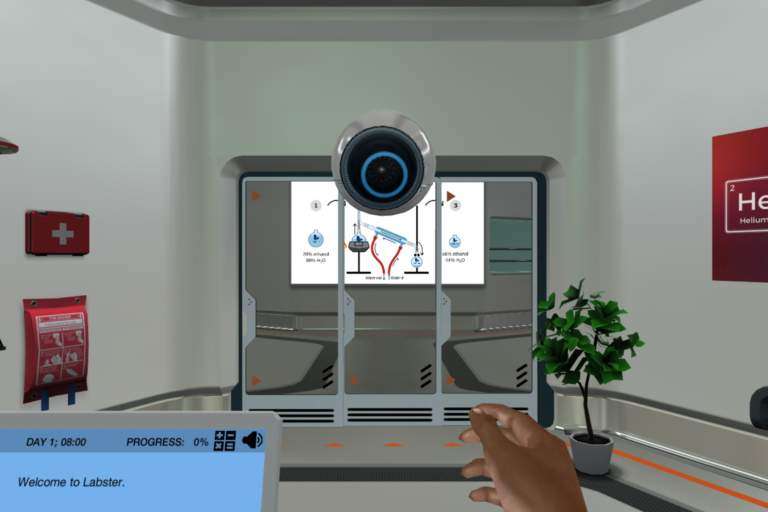Heading 1
Heading 2
Heading 3
Heading 4
Heading 5
Heading 6
Lorem ipsum dolor sit amet, consectetur adipiscing elit, sed do eiusmod tempor incididunt ut labore et dolore magna aliqua. Ut enim ad minim veniam, quis nostrud exercitation ullamco laboris nisi ut aliquip ex ea commodo consequat. Duis aute irure dolor in reprehenderit in voluptate velit esse cillum dolore eu fugiat nulla pariatur.
Block quote
Ordered list
- Item 1
- Item 2
- Item 3
Unordered list
- Item A
- Item B
- Item C
Bold text
Emphasis
Superscript
Subscript
About This Simulation
Rescue a town from a fuel crisis by using your knowledge about matter and phase changes principles and performing ethanol distillation.
Learning Objectives
- Read a phase diagram and explain each region
- Interpret a heating curve of a given substance
- Explain the difference between a heating curve and a phase diagram
- Understand the basic steps of performing a distillation
- Distinguish between physical and chemical properties of matter and classify changes of matter as physical or chemical
About This Simulation
Lab Techniques
- Distillation
Related Standards
- Early Stage Bachelors Level
- EHEA First Cycle
- EHEA Short Cycle
- FHEQ 5
- FHEQ 6
- FHEQ 4
- US College Year 2
- US College Year 1
- Support for laboratory skills at all levels
- HS-PS1-3
- HS-PS1-4
- HS-PS1-8
- HS-PS1-5
- PS1.A-E2
- Chemistry 3.1. Intermolecular Forces
- Chemistry 3.3 Solids, Liquids, and Gases
- Chemistry 4.4 Physical and Chemical Changes
- Chemistry 6.5 Energy of Phase Changes
- Chemistry 4.4 Intermolecular forces
Learn More About This Simulation
This short, targeted simulation is adapted from the full-length “Matter and Phase Changes: Distil ethanol” simulation.
Get ready to encounter how great the distillation technique is! In this simulation, you will help a town concentrate ethanol in order to support them during their fuel shortage crisis. Are you ready to learn how to separate a homogeneous mixture of liquids?
Explore the difference between physical and chemical change
In the Separating Mixtures simulation, you will meet Jo who has a limited fuel supply and therefore wants to produce bioethanol. In order to help her, you must first know the difference between the physical and chemical change of a substance in order to find the right technique.
Generate heating curves
Once you’ve mastered the basics, you are ready to learn about additional aspects of phase changes and be introduced to heat curves. You will learn how to interpret heating curves to identify important information of the boiling point of ethanol and water at atmospheric pressure. By doing so, you will be able to decode the meaning of each line of the heating curves and understand how this information is useful to your experiment. You will also be introduced to phase diagrams and understand how other physical properties can be predicted through this data.
Perform distillation
Once you have understood why distillation is the right technique, the next step is to perform it. At the end of the simulation, you will put your newly acquired knowledge to the test! You are going to use the distillation technique to achieve ethanol with higher purity. Will you be able to produce high purity ethanol and report your findings to Jo?
For Science Programs Providing a Learning Advantage
Boost STEM Pass Rates
Boost Learning with Fun
75% of students show high engagement and improved grades with Labster
Discover Simulations That Match Your Syllabus
Easily bolster your learning objectives with relevant, interactive content
Place Students in the Shoes of Real Scientists
Practice a lab procedure or visualize theory through narrative-driven scenarios


FAQs
Find answers to frequently asked questions.
Heading 1
Heading 2
Heading 3
Heading 4
Heading 5
Heading 6
Lorem ipsum dolor sit amet, consectetur adipiscing elit, sed do eiusmod tempor incididunt ut labore et dolore magna aliqua. Ut enim ad minim veniam, quis nostrud exercitation ullamco laboris nisi ut aliquip ex ea commodo consequat. Duis aute irure dolor in reprehenderit in voluptate velit esse cillum dolore eu fugiat nulla pariatur.
Block quote
Ordered list
- Item 1
- Item 2
- Item 3
Unordered list
- Item A
- Item B
- Item C
Bold text
Emphasis
Superscript
Subscript
A Labster virtual lab is an interactive, multimedia assignment that students access right from their computers. Many Labster virtual labs prepare students for success in college by introducing foundational knowledge using multimedia visualizations that make it easier to understand complex concepts. Other Labster virtual labs prepare learners for careers in STEM labs by giving them realistic practice on lab techniques and procedures.
Labster’s virtual lab simulations are created by scientists and designed to maximize engagement and interactivity. Unlike watching a video or reading a textbook, Labster virtual labs are interactive. To make progress, students must think critically and solve a real-world problem. We believe that learning by doing makes STEM stick.
Yes, Labster is compatible with all major LMS (Learning Management Systems) including Blackboard, Canvas, D2L, Moodle, and many others. Students can access Labster like any other assignment. If your institution does not choose an LMS integration, students will log into Labster’s Course Manager once they have an account created. Your institution will decide which is the best access method.
Labster is available for purchase by instructors, faculty, and administrators at education institutions. Purchasing our starter package, Labster Explorer, can be done using a credit card if you are located in the USA, Canada, or Mexico. If you are outside of North America or are choosing a higher plan, please speak with a Labster sales representative. Compare plans.
Labster supports a wide range of STEM courses at the high school, college, and university level across fields in biology, chemistry, physics, and health sciences. You can identify topics for your courses by searching our Content Catalog.















